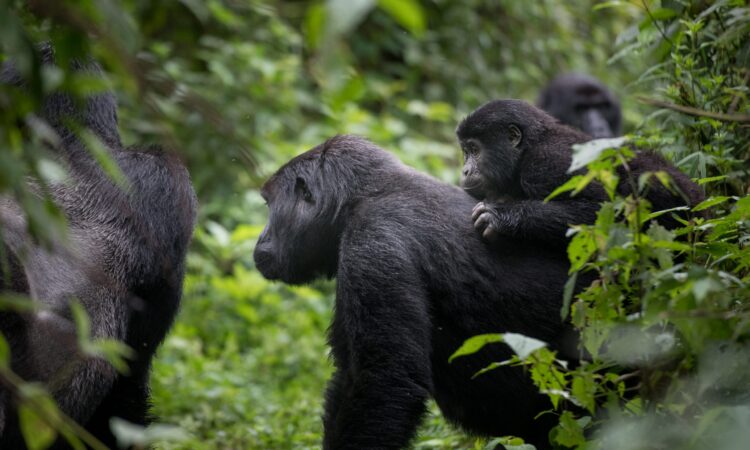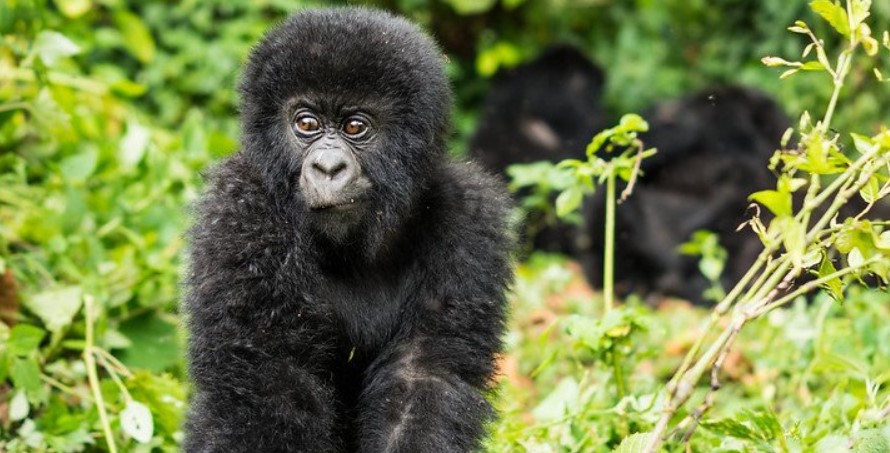Why is Gorilla Trekking One Hour? Gorilla trekking is an exciting and popular sport in which people travel through deep tropical rainforests in pursuit of endangered mountain gorillas and spend one hour with them in their natural environment.

Gorilla trekking is available in five African destinations: Mgahinga Gorilla National Park and Bwindi Impenetrable Forest National Park in Uganda, which houses half of the world’s mountain gorillas, Volcanoes national park in Rwanda, Virunga National Park and Kahuzi Biega National Park in the Democratic Republic of the Congo.
A tourist who wishes to go gorilla trekking in any of the gorilla locations must have a gorilla trekking permit, which is a document or card granted to all visitors over the age of fifteen that allows them to hike the endangered mountain gorillas.
Reasons why gorilla trekking is One Hour.
Gorilla trekking takes between 2 and 7 hours of tracking a gorilla family, depending on the location of the gorillas, and once located, tourists spend an hour with them in their natural environment, snapping photographs, preserving the moments, and learning about their lifestyle, mannerisms, and habits, among other things.
Visitors are thus permitted to spend one hour with them for a variety of reasons, including gorilla trekking in Uganda, Rwanda, and the Democratic Republic of the Congo, which is one hour because gorillas are vulnerable to human diseases, and the more time visitors spend with the gorillas, the greater the chances of humans spreading diseases, and in order to prevent disease transmission, visitors are permitted to spend one hour with the mountain gorillas in their natural habitat.
Visitors are allowed to spend one hour with the mountain gorillas because there is a need for conservation of the mountain gorillas, and spending a lot of time with the endangered gorillas taking photos and watching them carry out their daily activities like feeding stresses the gorillas, so government officials in charge of tourism in Uganda, Rwanda, and the Democratic Republic of the Congo implemented a policy where visitors are allowed to spend one hour with the gorillas.
Mountain gorillas live in groups of 10 to 35 individuals, which include females, juveniles, infants, and the dominant silverback. Because they live in families, they have daily routines that include feeding, moving from place to place in search of food, resting, social life where they interact with each other, and the time for constructing nests for the next night; therefore, visitors only spend one hour so that the gorillas can continue with their daily routine without disruption.
Visitors who wish to spend more time with the gorillas in their natural habitat can choose for a gorilla habituation experience, which involves training the mountain gorillas to become accustomed to human presence. Gorilla habituation experience is only done in Bwindi Impenetrable Forest National Park’s Rushaga section, and it takes 2 to 3 years.

A team of researchers, park rangers, and guides conducts the gorilla habituation experience in Bwindi Impenetrable National Park, which enables a maximum of four tourists to participate. During the gorilla habituation process, guests are permitted to spend four hours with the mountain gorillas while monitoring, observing, and identifying the gorillas.
Where is Gorilla Trekking Done?
Gorilla trekking is done in a variety of locations that provide remarkable experiences, such as Bwindi Impenetrable National Park, which is the most visited gorilla destination in Africa since it is home to almost half of the world’s mountain gorillas. The national park is located in southwestern Uganda’s Kanungu region and is home to 19 habituated gorilla families spread across four sectors: Rushaga, Nkuringo, Buhoma, and Ruhija.
Mgahinga Gorilla National Park is another gorilla destination situated in Uganda’s Southwestern province in Kisoro district and home to two habituated gorilla families, the Nyakagezi and Hirwa families. Volcanoes National Park is located in northwestern Rwanda in Musanze village and is home to over 15 habituated gorilla families. Virunga National Park, located in the Democratic Republic of Congo, and home to 8 habituated gorilla families, and Kahuzi Biega National Park, which harbors 5 habituated gorilla families.
How much is a gorilla trekking permit in Uganda?
A gorilla trekking permit in Uganda costs $700 in both Bwindi Impenetrable and Mgahinga Gorilla National Parks. A gorilla trekking permit, on the other hand, should be booked 3 to 6 months before the trekking date to minimize disappointments because permits are competitive and sometimes sell out, especially during peak season.
When is the best time to go for gorilla trekking?
Gorilla trekking may be done at any time of year, although the optimum time is during the dry season, which lasts from June to September and December to February. Because there is less rainfall during the dry season, access roads to gorilla sites are passable, and the gorilla trekking routes in the forest are dry and passable, as opposed to the wet/rainy season, when the pathways are muddy and slippery, making gorilla trekking difficult.
What to pack for your gorilla trekking safari?
Visitors going on a gorilla trekking safari should bring gorilla trekking essentials such as hiking shoes to keep your feet dry, long-sleeved shirt and trousers to keep you warm, a rain jacket to protect you from rain, a warm sweater, a backpack to carry your essentials, energy snacks, walking stick, camera, and so on.
In summary; Gorilla trekking is an exciting activity that will provide you with stunning and once-in-a-lifetime safari experiences as you spend one hour with them in their natural environment. If you want to go gorilla trekking, contact Explore Rwanda Tours for gorilla trekking packages.


